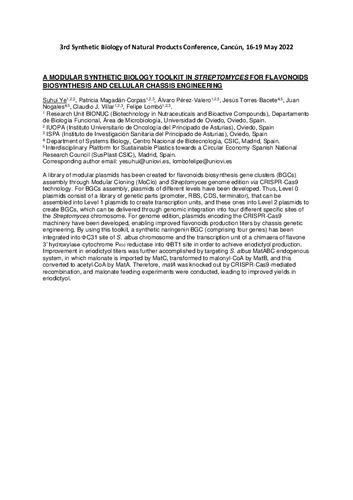A modular synthetic biology toolkit in streptomyces for flavonoids biosynthesis and cellular chassis engineering
Fecha de publicación:
Resumen:
A library of modular plasmids has been created for flavonoids biosynthesis gene clusters (BGCs) assembly through Modular Cloning (MoClo) and Streptomyces genome edition via CRISPR-Cas9 technology. For BGCs assembly, plasmids of different levels have been developed. Thus, Level 0 plasmids consist of a library of genetic parts (promoter, RBS, CDS, terminator), that can be assembled into Level 1 plasmids to create transcription units, and these ones into Level 2 plasmids to create BGCs, which can be delivered through genomic integration into four different specific sites of the Streptomyces chromosome. For genome edition, plasmids encoding the CRISPR-Cas9 machinery have been developed, enabling improved flavonoids production titers by chassis genetic engineering. By using this toolkit, a synthetic naringenin BGC (comprising four genes) has been integrated into C31 site of S. albus chromosome and the transcription unit of a chimaera of flavone 3’ hydroxylase-cytochrome P450 reductase into BT1 site in order to achieve eriodictyol production. Improvement in eriodictyol titers was further accomplished by targeting S. albus MatABC endogenous system, in which malonate is imported by MatC, transformed to malonyl-CoA by MatB, and this converted to acetyl-CoA by MatA. Therefore, matA was knocked out by CRISPR-Cas9-mediated recombination, and malonate feeding experiments were conducted, leading to improved yields in eriodictyol.
A library of modular plasmids has been created for flavonoids biosynthesis gene clusters (BGCs) assembly through Modular Cloning (MoClo) and Streptomyces genome edition via CRISPR-Cas9 technology. For BGCs assembly, plasmids of different levels have been developed. Thus, Level 0 plasmids consist of a library of genetic parts (promoter, RBS, CDS, terminator), that can be assembled into Level 1 plasmids to create transcription units, and these ones into Level 2 plasmids to create BGCs, which can be delivered through genomic integration into four different specific sites of the Streptomyces chromosome. For genome edition, plasmids encoding the CRISPR-Cas9 machinery have been developed, enabling improved flavonoids production titers by chassis genetic engineering. By using this toolkit, a synthetic naringenin BGC (comprising four genes) has been integrated into C31 site of S. albus chromosome and the transcription unit of a chimaera of flavone 3’ hydroxylase-cytochrome P450 reductase into BT1 site in order to achieve eriodictyol production. Improvement in eriodictyol titers was further accomplished by targeting S. albus MatABC endogenous system, in which malonate is imported by MatC, transformed to malonyl-CoA by MatB, and this converted to acetyl-CoA by MatA. Therefore, matA was knocked out by CRISPR-Cas9-mediated recombination, and malonate feeding experiments were conducted, leading to improved yields in eriodictyol.
Descripción:
Synthetic Biology of Natural Products Conference (3rd. 2022. Cancún, México)
Colecciones
- Biología Funcional [807]
- Pósteres [94]
Ficheros en el ítem





